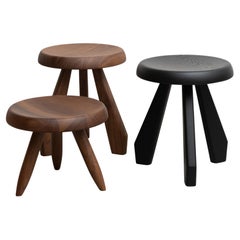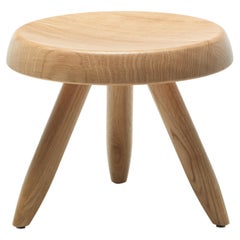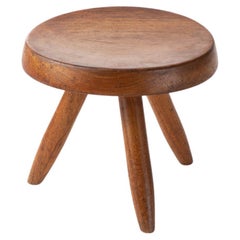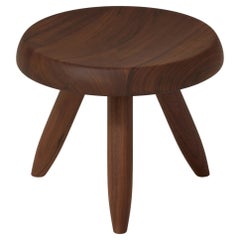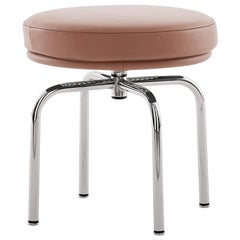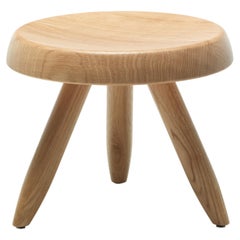Charlotte Perriand Stools
A pioneer of modernism in France, Charlotte Perriand was one of the most influential figures in 20th-century design and architecture. In her long career, Perriand’s aesthetic grammar constantly evolved, moving from the tubular steel furniture of the Machine Age to a lyrical naturalism that is reflected in her enduring designs for chairs, sconces, daybeds and other works.
Perriand’s studies at the Ecole de L'Union Centrale de Arts Decoratifs left her enthralled by Charles-Édouard "Le Corbusier" Jeanneret and his vision of a new, rational architecture. In 1924, she joined his studio to design furniture along with Pierre Jeanneret, Corbu’s partner and cousin.
Together, they devised some of the finest examples of early modernist furniture, including two icons of the era: the B306 chaise — later renamed the LC4 — with its swooping frame and hide upholstery; and the chunky, steel-framed Grand Confort club chair. Both pieces were part of the LC line, which saw the trio of designers carrying out bold experiments with tubular chromed steel, just as architect and Bauhaus faculty member Marcel Breuer had executed with his cantilever Cesca chair around the same time. (Furniture created by Perriand, Le Corbusier and Pierre Jeanneret was originally produced by Austrian manufacturer Thonet but Italian firm Cassina acquired the production and sales rights to their works in 1964.)
Collaborative design produced another Perriand triumph: in the early 1950s, she and Jean Prouvé were engaged to produce desks, worktables and bookcases for the University of Paris. The bookcases — slim pine shelves with brightly painted aluminum dividers — are minimalist mid-century masterpieces.
By the end of that decade, Perriand’s aesthetic had changed completely from the earliest days of her career. She produced a series of furniture in ebonized wood: chairs with gentle S-curve legs, front and back; tables with elliptical tops. In the 1960s, Perriand pushed the boundaries of prefab to produce high-quality housing and furnishings at low cost for the French ski resort Les Arcs. She also adopted an almost rustic look at the time, designing simple chairs with dowel-cut frames and rush seats.
Everything in Perriand’s oeuvre is beautiful, whether it’s the centerpiece of a décor or an accent, and her work is in every great design collection, public and private.
The vintage Charlotte Perriand furniture for sale on 1stDibs includes stools, coffee tables, case pieces, lighting and more.
2010s Italian Mid-Century Modern Charlotte Perriand Stools
Wood
2010s Italian Mid-Century Modern Charlotte Perriand Stools
Wood
1950s French Vintage Charlotte Perriand Stools
Mahogany
2010s Italian Mid-Century Modern Charlotte Perriand Stools
Aluminum
2010s Italian Mid-Century Modern Charlotte Perriand Stools
Steel
2010s Italian Mid-Century Modern Charlotte Perriand Stools
Aluminum
2010s Italian Mid-Century Modern Charlotte Perriand Stools
Aluminum
2010s Italian Mid-Century Modern Charlotte Perriand Stools
Steel
21st Century and Contemporary Italian Mid-Century Modern Charlotte Perriand Stools
Oak, Walnut
2010s Italian Mid-Century Modern Charlotte Perriand Stools
Steel
2010s Italian Mid-Century Modern Charlotte Perriand Stools
Steel
2010s Italian Mid-Century Modern Charlotte Perriand Stools
Aluminum
2010s Italian Mid-Century Modern Charlotte Perriand Stools
Steel
Mid-20th Century French Mid-Century Modern Charlotte Perriand Stools
Metal
Mid-20th Century French Mid-Century Modern Charlotte Perriand Stools
Metal
1950s French Mid-Century Modern Vintage Charlotte Perriand Stools
Ash
Mid-20th Century French Mid-Century Modern Charlotte Perriand Stools
Pine
2010s Italian Mid-Century Modern Charlotte Perriand Stools
Metal
Mid-20th Century European Mid-Century Modern Charlotte Perriand Stools
Metal, Chrome
1950s French Vintage Charlotte Perriand Stools
Pine
1970s French Mid-Century Modern Vintage Charlotte Perriand Stools
Pine
2010s Italian Mid-Century Modern Charlotte Perriand Stools
Metal
1960s French Vintage Charlotte Perriand Stools
Pine
Mid-20th Century French Mid-Century Modern Charlotte Perriand Stools
Straw, Oak
1960s French Mid-Century Modern Vintage Charlotte Perriand Stools
Pine
2010s Italian Mid-Century Modern Charlotte Perriand Stools
Steel
1950s French Modern Vintage Charlotte Perriand Stools
Hardwood
1960s French Mid-Century Modern Vintage Charlotte Perriand Stools
Pine
Mid-20th Century French Mid-Century Modern Charlotte Perriand Stools
Wood, Straw
1960s French Mid-Century Modern Vintage Charlotte Perriand Stools
Chrome
1950s French Mid-Century Modern Vintage Charlotte Perriand Stools
Wood
2010s Italian Mid-Century Modern Charlotte Perriand Stools
Wood
1950s French Mid-Century Modern Vintage Charlotte Perriand Stools
Wood
21st Century and Contemporary Italian Mid-Century Modern Charlotte Perriand Stools
Wood, Oak, Walnut
1960s French Mid-Century Modern Vintage Charlotte Perriand Stools
Pine
21st Century and Contemporary Italian Mid-Century Modern Charlotte Perriand Stools
Steel
2010s Italian Mid-Century Modern Charlotte Perriand Stools
Wood
Mid-20th Century French Charlotte Perriand Stools
Pine
1960s French Mid-Century Modern Vintage Charlotte Perriand Stools
Pine
20th Century French Mid-Century Modern Charlotte Perriand Stools
Wood, Pine
2010s Italian Mid-Century Modern Charlotte Perriand Stools
Aluminum
2010s Italian Mid-Century Modern Charlotte Perriand Stools
Plywood
1950s French Mid-Century Modern Vintage Charlotte Perriand Stools
Wood, Mahogany
1930s French Mid-Century Modern Vintage Charlotte Perriand Stools
Straw, Ash
1960s French Mid-Century Modern Vintage Charlotte Perriand Stools
Pine
2010s Italian Mid-Century Modern Charlotte Perriand Stools
Aluminum
2010s Italian Mid-Century Modern Charlotte Perriand Stools
Aluminum
1960s French Mid-Century Modern Vintage Charlotte Perriand Stools
Pine
2010s Italian Mid-Century Modern Charlotte Perriand Stools
Wood
1960s French Mid-Century Modern Vintage Charlotte Perriand Stools
Straw, Ash
1950s French Vintage Charlotte Perriand Stools
Pine
Mid-20th Century French Mid-Century Modern Charlotte Perriand Stools
Ash
1960s French Vintage Charlotte Perriand Stools
Pine
1960s French Mid-Century Modern Vintage Charlotte Perriand Stools
Pine
Mid-20th Century French Mid-Century Modern Charlotte Perriand Stools
Metal
1950s French Modern Vintage Charlotte Perriand Stools
Mahogany
2010s Italian Mid-Century Modern Charlotte Perriand Stools
Aluminum
1960s French Scandinavian Modern Vintage Charlotte Perriand Stools
Cherry
2010s Italian Mid-Century Modern Charlotte Perriand Stools
Plywood
1960s French Mid-Century Modern Vintage Charlotte Perriand Stools
Metal
Charlotte Perriand stools for sale on 1stDibs.
Creators Similar to Charlotte Perriand
- 1stDibs ExpertFebruary 27, 2024Charlotte Perriand made a variety of chairs, stools, coffee tables, case pieces, lighting and other types of furniture. Some of her most notable works include the B306 chaise, later renamed the LC4, and the chunky, steel-framed Grand Confort club chair, both of which she designed collaboratively with Pierre Jeanneret and Le Corbusier. She is also known for producing an acclaimed series of furniture in ebonized wood. Explore a wide range of Charlotte Perriand furniture on 1stDibs.
- 1stDibs ExpertFebruary 21, 2024Charlotte Perriand is known for being a pioneer of modernism in France. She was one of the most influential figures in 20th-century design and architecture. In her long career, Perriand’s aesthetic grammar constantly evolved, moving from the tubular steel furniture of the Machine Age to a lyrical naturalism that is reflected in her enduring designs for chairs, sconces, daybeds and other works. Explore a diverse assortment of Charlotte Perriand furniture on 1stDibs.
- 1stDibs ExpertMarch 22, 2022To pronounce Charlotte Perriand, say "Shar-LOAT PAIR-ee-uh." Her surname is French, and in that language "and" represents a sound somewhere between "uh" and "ah," rather than rhyming with land and sand and it does in English. You'll find a collection of Charlotte Perriand furniture on 1stDibs.
- 1stDibs ExpertMarch 22, 2022Charlotte Perriand worked in the studio of the Swiss-French architect Le Corbusier. She frequently collaborated with fellow designer Pierre Jeanneret. Together, they created two legendary modern furniture designs: the B306 chaise and the Grand Confort club chair. Shop a range of Charlotte Perriand furniture on 1stDibs.
- 1stDibs ExpertFebruary 1, 2024Charlotte Perriand was part of the modern design movement. Many people consider her to be a pioneer of modernism in France and one of the most influential figures in 20th-century design and architecture. In her long career, Perriand's aesthetic grammar constantly evolved, moving from the tubular steel furniture of the Machine Age to a lyrical naturalism that is reflected in her enduring designs for chairs, sconces, daybeds and other works. Find a selection of Charlotte Perriand furniture on 1stDibs.
